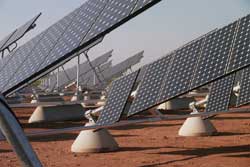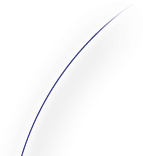Design Methods for Solar Concentrator Photovoltaic Systems
Background
 The high cost of photovoltaic (PV) cells poses a serious obstacle to cost-effective generation of solar electricity. A good way to reduce costs is to increase PV cell efficiencies while minimizing the use of costly materials and fabrication techniques.
The high cost of photovoltaic (PV) cells poses a serious obstacle to cost-effective generation of solar electricity. A good way to reduce costs is to increase PV cell efficiencies while minimizing the use of costly materials and fabrication techniques.
One promising way to accomplish this is with concentrator PV (CPV) systems, where an inexpensive optical element (usually made of glass) covering a large sun-lit area is used to greatly concentrate the light onto a small PV cell. Higher light intensities enable higher efficiencies in converting sunlight to electricity while greatly reducing the size of the PV cell required.
This has been a difficult goal to attain, however, since conversion efficiency and other key cost factors in CPV design are governed by multiple variables, including the degree of light concentration, the efficiency of light transmission to the PV cell, the acceptance angle of the primary optical element, and the compactness of the optical elements. To achieve such gains in conversion efficiency, there is a pressing need for novel design methods that meet the unique optical requirements of solar concentrators.
Description
A researcher at the University of California, Merced has developed a general method for designing optical systems incorporating reflective and/or refractive elements that uniformly illuminate an exit aperture. This, in turn, can be a suitable location for a PV cell or for an entry aperture of an additional non-imaging concentrator.
Since the sun is an extended light source that may be slightly off-axis, there are stringent requirements for the design of the reflective and refractive elements, specifically to homogenize light to achieve Köhler illumination of the exit aperture.
The UC Merced researcher has specified a general mathematical representation of these requirements that can be used to optimize a wide variety of CPV designs.
Applications
This CPV design method is of general application in this field, including commonly-used configurations of optical elements such as Cassegrain and Fresnel designs. It has already been used as the basis for a number of other recent UC Merced CPV inventions, including a CPV that is in commercial production.
Advantages
Because of the importance of optimizing multiple parameters in practical CPV systems, design methods of this type are indispensable for realizing the full potential of CPV for reducing the costs of generating solar electricity.
Patent Status
Patent Pending
Inventor
Roland Winston







